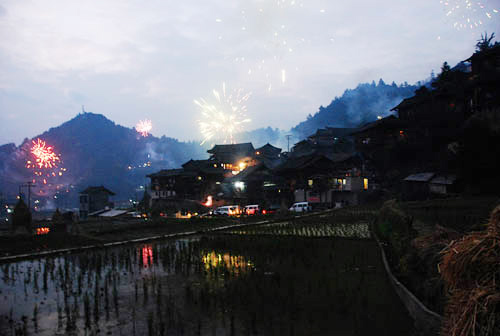|
 |
|
NIGHT SCENE: New Year fireworks light up a Miao village in Leishan County, southwest China's Guizhou Province, on November 9 (CHEN RAN) |
The black-tile wooden stilts built on the hillsides were shrouded in haze by the stunning fireworks. From the rice terraces in front of the stilts, one could see the reflections of people bearing gifts, bound for home.
On November 9, Liao Bin, 80, and his wife Liang Lixia, 77, were excited to experience the New Year celebration of the Miao ethnic minority group in Danjiang Town of Leishan County in southwest China's Guizhou Province.
Coming from Zhanjiang City in south China's Guangdong Province some 1,100 km away, the couple spends at least three months traveling each year, and since 1993 they have visited 30 countries and regions to see every UNESCO world heritage site.
According to the Miao calendar, this New Year (around November 10) coincided with the Guzang Festival (Gu means drum, Zang means to bury), one of the grandest festivals of the Miao people, held only once every 13 years to commemorate their ancestors.
According to tradition, every family would invite their relatives and friends to the house to carry pig legs on the eve of the month-long celebration. The more guests, the happier the host. Guests would bring a duck, rice liquor, and fish (five, seven or nine), set off fireworks in front of the host's house in return, and stay overnight.
"We searched for information on the Internet, and came to Guizhou on November 4," the husband told Beijing Review. "We are going to stay overnight at the home of a senior leader of the Miao village and we are looking forward to experiencing authentic Miao culture."
Beyond national intangible heritage
Located some 180 km away from the provincial capital of Guiyang, Leishan County is regarded as a holy place among Miao villages, as 84.2 percent of its population is of the Miao ethnic minority group.
The county's 130 dynamic villages have formed a relatively complete system of preserving Miao cultural heritage. A total of 11 occasions in Leishan, including the Miao New Year and the Guzang Festival, were listed as examples of national intangible heritage as of 2009.
| 